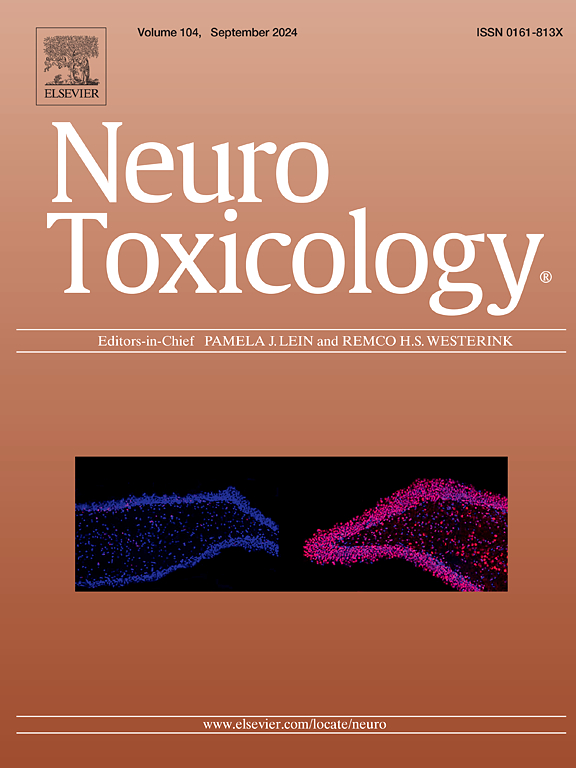橙皮苷通过tfeb依赖性线粒体功能、氧化平衡和大鼠神经炎症的恢复减轻铅诱导的神经毒性
IF 3.9
3区 医学
Q2 NEUROSCIENCES
引用次数: 0
摘要
铅(Pb)神经毒性是一个全球关注的问题,它通过线粒体功能障碍、氧化应激和炎症等机制引起不可逆转的认知和运动障碍。转录因子EB (TFEB)是溶酶体生物发生和自噬的主要调节因子,也协调线粒体功能,已成为神经保护的新靶点。本研究评估了橙皮苷(天然类黄酮)对铅诱导的神经毒性的神经保护潜力,重点研究了TFEB的作用。大鼠每日口服醋酸铅(100 mg/kg) 1次,连续30天诱导神经毒性,然后给予橙皮苷(50和100 mg/kg, p.o.)处理。通过Morris水迷宫和rotarod测试评估认知和运动功能,生化分析测量氧化应激标志物(TBARS、GSH)、炎症因子(TNF-α、IL-6、NF-κB)和线粒体复合体I-III活性。铅暴露会显著损害学习、记忆和运动协调能力,增加氧化和炎症标志物,降低线粒体功能。橙皮苷治疗改善了行为结果,恢复了氧化还原平衡、炎症标志物和线粒体酶活性。然而,与TFEB抑制剂eltrombopag联合治疗,消除了这些保护作用,证实了TFEB的参与。这些发现强调了橙皮苷通过tfeb介导的线粒体功能恢复和氧化应激和炎症抑制来减轻Pb神经毒性的能力。靶向TFEB可能为重金属诱导的神经退行性变提供一种新的治疗策略。本文章由计算机程序翻译,如有差异,请以英文原文为准。
Hesperidin mitigates lead-induced neurotoxicity via TFEB-dependent restoration of mitochondrial function, oxidative balance, and neuroinflammation in rats
Lead (Pb) neurotoxicity remains a global concern, causing irreversible cognitive and motor impairments through mechanisms like mitochondrial dysfunction, oxidative stress and inflammation. Transcription Factor EB (TFEB), a master regulator of lysosomal biogenesis and autophagy that also coordinates mitochondrial function, has emerged as a novel target in neuroprotection. This study evaluated the neuroprotective potential of hesperidin (natural flavonoid) against Pb-induced neurotoxicity, with a focus on the role of TFEB. Rats were orally administered lead acetate (100 mg/kg) once daily for 30 days to induce neurotoxicity, followed by hesperidin (50 and 100 mg/kg, p.o.) treatment. Cognitive and motor functions were assessed through Morris Water Maze and rotarod tests, while biochemical analyses measured oxidative stress markers (TBARS, GSH), inflammatory cytokines (TNF-α, IL-6, NF-κB), and mitochondrial complex I–III activities. Pb exposure significantly impaired learning, memory, and motor coordination, increased oxidative and inflammatory markers, and reduced mitochondrial function. Hesperidin treatment improved behavioral outcomes and restored redox balance, inflammatory markers and mitochondrial enzyme activity. However, co-treatment with eltrombopag, a TFEB inhibitor, abolished these protective effects, confirming TFEB’s involvement. These findings highlight hesperidin’s ability to mitigate Pb neurotoxicity through TFEB-mediated restoration of mitochondrial function and suppression of oxidative stress and inflammation. Targeting TFEB may offer a novel therapeutic strategy for heavy metal-induced neurodegeneration.
求助全文
通过发布文献求助,成功后即可免费获取论文全文。
去求助
来源期刊

Neurotoxicology
医学-毒理学
CiteScore
6.80
自引率
5.90%
发文量
161
审稿时长
70 days
期刊介绍:
NeuroToxicology specializes in publishing the best peer-reviewed original research papers dealing with the effects of toxic substances on the nervous system of humans and experimental animals of all ages. The Journal emphasizes papers dealing with the neurotoxic effects of environmentally significant chemical hazards, manufactured drugs and naturally occurring compounds.
 求助内容:
求助内容: 应助结果提醒方式:
应助结果提醒方式:


